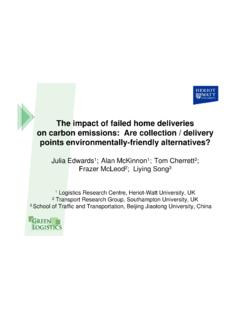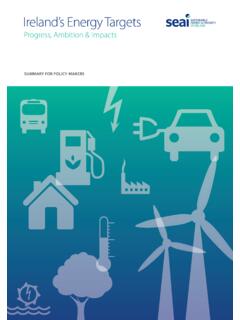Transcription of Estimating CO2 Emissions from Freight Transport
1 CO2 Emissions from Freight Transport : An Analysis of UK Data Alan McKinnon Logistics Research Centre, Heriot-Watt University, Edinburgh, UK EH10 7HR Tel 0044 131 451 3850 Fax 0044 131 451 3498 Email: Abstract As governments are setting targets for CO2 reduction, it is important that the contribution of different sectors to greenhouse gas Emissions is accurately measured. This paper summarises the results of an analysis of CO2 Emissions from the Freight Transport sector within the UK. It reveals significant discrepancies in the available statistics and highlights serious difficulties in calculating emission values for waterborne Freight and air cargo. Using the best available available data, it is estimated that million tonnes of CO2 were emitted from Freight Transport operations in 2004, approximately 6% of total UK CO2 Emissions .
2 Key Words: CO2, climate change, Freight Transport , carbon intensity, Introduction In recent years, the issue of climate change has risen up political and corporate agendas at an astonishing rate. Widespread acceptance of the basic science of climate change and recognition of the potential threat that it poses to our ecosystem and way of life has made the pursuit of CO2 reductions a major priority for many governments and companies. At an early stage in the development of a carbon reduction strategy it is necessary to analyse the main sources of CO2 Emissions and identify those activities upon which carbon mitigation measures should be targeted. National governments have been establishing more elaborate systems for monitoring CO2 Emissions , in accordance with guidelines proposed by the Inter-governmental Panel on Climate Change (IPCC).
3 Some, such as the UK government, have also given companies advice on how to collect, analyse and report data on their 'carbon footprints' (DEFRA, 2005). Detailed carbon auditing at an individual company level and across supply chains is still at a formative stage, however. This paper summarises the results of a macro-level analysis undertaken for the UK Government s Commission for Integrated Transport of CO2 Emissions from domestic Freight Transport operations. This work revealed discrepancies in different sets of government statistics and identified areas where, at best, only crude estimates could be made, often involving extrapolation from research done in other countries. Subsequent analysis has been conducted as part of a multi-university research project called Green Logistics. Interpreting CO2 Data for Freight Transport Great care must be exercised in interpreting the available CO2 for Freight , for several reasons: (i) Differing assumptions about the utilisation of vehicle capacity: The amount of fuel consumed, and hence CO2 emitted, is very sensitive to vehicle load factors.
4 Agencies promoting particular Transport modes as being more green sometimes base CO2 calculations for their mode on high levels of utilisation while using average load factor data for competing modes. (ii) Use of parameters derived from international studies: in the absence of carbon intensity data for Freight Transport operations in a particular country, researchers often rely on intensity values calculated for other countries or international averages. This is risky as there are wide international differences in the nature and efficiency of Freight Transport operations, in the primary source of electricity (for rail and pipeline) and in the condition of Transport infrastructure. (iii) Sectoral allocation of CO2 Emissions . In the UK Environmental Accounts (Office of National Statistics, 2007), sectors are typically defined by their dominant activity.
5 Where Freight Transport is undertaken on an own account basis by companies whose main activity is not Transport , the related Freight Emissions are excluded. This makes it difficult to obtain a comprehensive, cross-sectoral measure of CO2 Emissions from Freight Transport . The UK government now advises data users to be aware that the road Freight industry comprises solely the specialist road haulage companies and not all road Freight activities (Department for Transport , 2006). This was not made clear when official statistics were released in 2004, suggesting that CO2 Emissions from HGVs had risen by almost 50% between 1990 and 2002. These statistics, however, excluded many own account operators of lorries. During the 1990s, there was a significant switch from own account to hire and reward Transport operations as more companies outsourced their distribution.
6 This had the effect, ceteris paribus, of increasing fuel purchases by the hire and reward sector. This represented a transfer of the demand for fuel between different road Freight sectors rather than a net increase in the total demand for fuel and CO2 Emissions . (iv) Use of tonne-kms as the output measure for Freight Transport : Analyses of the carbon intensity of Freight Transport invariably express CO2 Emissions as a ratio of tonne-kms, weight transported multiplied by the distance travelled. For some modes and commodity types it would be more appropriate to measure Freight movement in terms of volume rather than weight. Lack of government statistics on the cubic volume of Freight makes this impossible, however. (v) Movement of Freight in passenger vehicles: A significant amount of Freight (mainly shopping) is moved in cars or public Transport vehicles.
7 This does not appear in any official statistics and so has not been included in CO2 calculations for Freight Transport . With the growth of online shopping, responsibility for the last mile delivery to the home is transferring from the consumer to the retailer / delivery company. The movement of online retail purchases in vans increases its statistical visibility. Around 70% of airfreight moves in the bellyholds of passenger aircraft (Department for Transport , 2003), making it difficult to isolate its CO2 contribution. (vi) CO2 and other global warming gases: CO2 is only one of several gases which contribute to global warming. It is estimated to account for around 84% of the global warming impact of the Transport sector. This paper is solely concerned with CO2 Emissions from Freight Transport operations.
8 General Approaches to Measuring CO2 Emissions A distinction can be drawn between two approaches: Input-based measures: these are derived from estimates of the fuel / energy purchased by / supplied to companies in particular sectors. These are essentially top-down measures. As discussed earlier, however, the practice of defining sectors with respect to dominant activities makes it difficult to obtain disaggregated CO2 estimates for ancillary services such as logistics. Output-based measures: these are derived from estimates of the actual amount of work done and the energy consumed per unit of output. The output of Freight Transport operations is generally measured by tonne-kms and energy consumption by litres of fuel or kilowatt-hours of electricity used per tonne-km. When based on extensive surveys of Freight Transport operators, these bottom-up measures usually provide accurate estimates of CO2 Emissions For most Freight Transport modes both types of CO2 measure are available.
9 In the case of aviation, only output-based measures are available and these do not differentiate passenger from Freight movements. Most of the statistics presented in the remainder of the paper are derived from output-based measures. Estimation of CO2 Emissions for Different Transport Modes Road Freight Heavy Goods Vehicles (HGVs) The Continuing Survey of Road Goods Transport (CSRGT) is the main government survey of road Freight operations in the UK (Department for Transport , 2005a). Since 1989 it has included a question about fuel consumption. This survey covers around 16,000 vehicles and monitors their activities over a period of one week. By relating the amount of fuel the vehicle consumed in the survey week to the distance it travelled, it is possible to calculate the average fuel efficiency.
10 Road-side traffic counts are used to measure the amount of lorry movement on the road network. Unlike the CSRGT which only monitors the activities of UK-registered trucks, the road traffic surveys record the movements of domestic and foreign 2vehicles (Department for Transport , 2005b). Estimates of lorry-kms based on these counts can be combined with fuel efficiency ratios from the CSRGT to calculate total fuel consumption and CO2 Emissions . Deriving CO2 estimates in this way makes it possible to disaggregate Emissions by road type and location. This output-based analysis suggests that there has been an increase in Emissions of to million tonnes over the period 1990 to 2004. As road tonne-kms grew at twice this rate, the average CO2-intensity of HGV operations declined, mainly as a result of a reduction in empty running, an increase in average payload weight and improved fuel efficiency (McKinnon, 2007).












